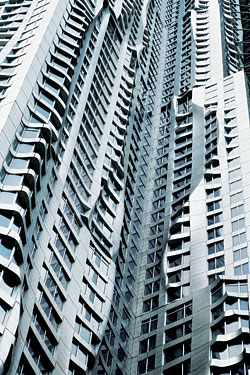
W ith its crinkled-steel drapery that catches the sun and casts plunging shadows, Frank Gehry’s new tower at 8 Spruce Street, at the base of the Brooklyn Bridge, is an architectural diva trying to upstage the Woolworth Building. Beneath that extravagant costume is an unremarkable body: a T-plan apartment building standing on a brick box pedestal and turning a flattened, featureless profile toward the south. But, oh, that opulent metallic gown, which could practically have emerged from the Metropolitan Opera costume shop—a princess’s robe, tailored to awe the multitudes.
Gehry would have loved to design a tall, twisting corkscrew, but that would have contorted plumbing lines and produced other construction extravagances. Instead, he confines the Gehry-ness to three façades, tucking quirky bay windows into the billows and sculpting folds that drop hundreds of feet. The thick wrap pulls away from the musculature, as it does in Bernini’s statue of Daphne squirming in Apollo’s grip. Gehry abstracts the Baroque contrast between glossy, unblemished flesh and sharply creased fabric whipping in the wind. The drama has moved from marble to steel, and those hectic folds set off the skyline’s naked glass towers.
That exterior does several jobs at once. It disguises the building’s fundamental ordinariness, demands adoration from various vantage points at different times of day, and intimates that all sorts of breathless fun is being had beneath that satiny, crumpled sheet. Gehry may not have reinvented the skyscraper, but he did pull off a brilliant theatrical trick.
